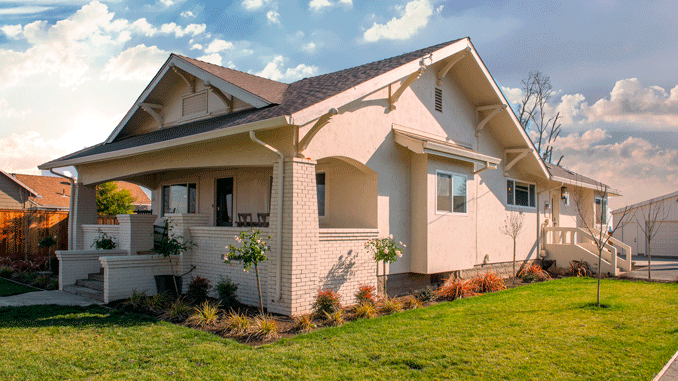
Liz and Ron Hittle have lived on Sargent Road for 20 years, always next door to an overgrown 100-year-old homestead house on a cattle ranch that hadn’t been maintained for 30 years. Despite its problems, something about the home charmed the couple, and they long told neighbors they would buy the property if it ever became available. In 2019, the dream became reality, and Liz and Ron closed on the three-bedroom, two-bath 1,900 square foot-house built on 1.3 acres at 3916 W. Sargent Rd. in Lodi.
While the couple went in on the project together, and Ron had a hand in much of the renovations, the vision was all Liz. The floors are a dark brown, almost black stain, the molding is painted black, the walls are a mushroom color in the main part of the home, and the bedrooms are white with black molding. “It is backward but it’s what I visualized,” Liz laments. “It is very different when you compare it to the norm.”
Maintaining Character
One of the Hittle’s main goals with the renovation was to keep as much of the existing charm and character as possible. “It was truly as-is condition,” Liz says. “Just about everything had to be fixed or maintained in some respect.” To complete an overhaul without losing the 20th century details proved difficult, but not impossible. “The house has been completely renovated inside but we kept all of the original woodwork,” Ron explains. To achieve that, they hired a local craftsman, M & L Molding and Machine, from Stockton to create woodwork that matched the old style and fill in any broken spots or gaps. Everything was completed custom to allow continuity throughout the home.
The flooring was another aspect Liz didn’t want to upset. Instead of ripping out the old floors, made of Douglas Fir (a common material in 1917 when the home was built), the couple had them sanded, stained, and restored to usable condition but didn’t fix all of the gouges and imperfections. Liz believes this process helped to preserve the home’s personality as well as give a nod to the era in which it was originally built. “There’s a lot of character to the flooring that is really unique,” Ron says.
All that being said, invisible upgrades were needed throughout, as well. From the plumbing to the wiring, it was a complete overhaul, including a new HVAC system and a new pump to work with the existing well.
Kitchen
The home hadn’t seen a renovation or redesign since the 1970s, which means the kitchen needed to be brought up to date. Here is where you will see many of the modern touches in the home, creating a truly functional space. To achieve the look, the kitchen had to be taken down to the studs. Then, new chrome Whirlpool and Samsung appliances were installed throughout the kitchen and black soapstone was used on the counters. For backsplash, the couple opted for an olive-taupe beadboard and they had new shaker cabinets installed by local carpenter Belco Cabinets in a gray-green shade. They also added a stylish drop-in sink. The wainscotting on one wall in the kitchen is original but painted to match the upgrades.
The large, open design didn’t require any major renovations as far as the structure of the space. No walls were torn down or moved to give it that open feel. The final touch was a custom-made iron table created by Wilder Designs Kyler Sinclair.
Bathrooms
Both bathrooms received major makeovers. One bathroom was taken down to the studs and rebuilt while the other received notable updates including new hardware and fixtures. The main materials used were marble, metal, and brass, with marble covering both the floors and the shower walls in the master. The fixtures, including the faucet, are brass, to compliment the dark color palette used in the master, and brushed chrome in the secondary bathroom. In order to tie some of the new materials and features into the rest of the home, the couple added beadboard to the bathroom. The colors also compliment the backward style of the rest of the house, which utilizes dark, bold colors instead of the light and airy feel of many modern spaces. In the bathroom, the prominent colors are black and green.
Living Room
The living room and bedrooms required most of the woodworking renovations, and the picture rail throughout the home was replaced, as well. The rock fireplace in the living room is also original. Liz admits she immediately thought it was an eyesore and planned to pull out the whole thing, but as the renovations around the fireplace were completed, she began to appreciate its style. “It’s probably one of my favorite pieces [in the house],” Liz admits now. Aside from reworking and gluing a couple of pieces, they didn’t change a stitch of the rock or petrified wood used to create it.
Dining Room
The dining room was the space that needed the least amount of work. Large stacks of papers and debris piled against the wall had actually preserved the room’s wood paneling. “We didn’t do anything to the wood in there,” Liz says. The couple simply painted the ceiling and the exposed parts of the wall. Even the hutch inside of the dining room is original to 1917.
Outdoors
Once overgrown, landscaping the backyard was one of the home’s larger projects, but the result is a space so gorgeous it’s already being used to host weddings. The front yard underwent a complete redesign and the driveway was expanded. The original patio was kept but iron railings—by the same welder who built the kitchen table—were included on the back steps for both safety and design. Crushed granite walkways were also added to make maneuvering the large space easier. In all, 60 trees were removed.
Overall Vibe
Funky and eclectic are the best ways to describe the home post-renovation. Once old, falling down, and covered in stacks of debris, the open home now has its own very distinct vibe. Habitat for Humanity and thrift stores played a big role in the renovation as Liz kept going back for secondhand pieces to furnish the space. “In a weird way they really fit,” Liz says of the melding of old and new designs. “It’s an unusual mix of things.”

